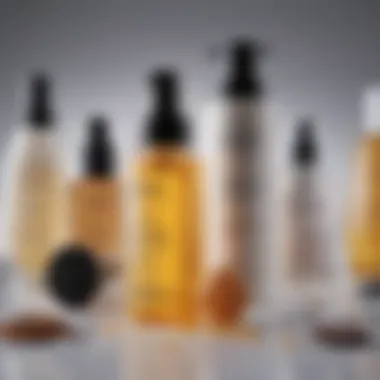Investigating Nioxin's Impact on Hair Loss


Intro
The relationship between hair care products and hair health is a topic of considerable interest. One specific brand that comes into the spotlight is Nioxin. Many consumers turn to Nioxin to address thinning hair and hair loss. However, emerges a question: does using Nioxin products potentially contribute to hair loss or exacerbate existing conditions?
This comprehensive examination will delve into the ingredients found in Nioxin formulations, the mechanisms by which these products operate, and user experiences reported by individuals. Additionally, it will highlight relevant scientific studies and gather insights from experts in the field. The intention is to provide readers with a clearer understanding of how Nioxin could affect hair health, thereby aiding informed hair care choices.
Understanding Nioxin Products
Nioxin offers a variety of products specifically designed for individuals experiencing hair thinning. Its line includes shampoos, conditioners, and treatment serums. Each product is formulated with a unique blend of ingredients aimed at cleansing the scalp, supporting hair density, and promoting a healthy scalp environment.
Key Ingredients
The efficacy of Nioxin products lies in their ingredients. Some critical components brands highlight include:
- Biotin: Often praised for its role in hair health, biotin may support hair strength and reduce brittleness.
- Niacinamide: This ingredient improves blood circulation to the scalp and might help revive hair follicles.
- Vitamins B6 and B12: Essential for overall hair health, these vitamins may contribute to healthier hair growth when combined with other supportive ingredients.
It remains to understand the role these ingredients play in hair loss. Some users may find benefits, while others may experience unwanted effects.
Mechanism of Action
Understanding how Nioxin products work is essential. Nioxin claims to enhance the environment of the scalp, which is crucial for healthy hair growth.
The cleansing formulations are designed to remove sebum and build-up that could impede hair health. By clearing these barriers, they may support the growth of stronger hair. Users often report feelings of a refreshed scalp after using these products.
User Experiences
The experiences shared by consumers provide insight into the effectiveness of Nioxin. Many users praise the products for their ability to create the illusion of thicker hair. Reviews often highlight an improved scalp condition and a decrease in hair fall for some individuals. However, it is crucial to mention that not every user will experience the same outcome.
Some users have reported an increase in hair loss after beginning to use Nioxin products. This can be surprising and concerning. Factors like incorrect product application or a reaction to a specific ingredient may influence these results.
"While I liked the way my hair felt after using Nioxin, I noticed more hair in my brush than before. It made me worry about whether I was doing the right thing for my hair.”
Scientific Studies
Various studies have been conducted to evaluate the effectiveness of hair care products, including those from Nioxin. Findings often vary, and while some studies support claims of improved hair health, others do not:
- A study from PubMed examined the impact of topical applications on hair growth and identified some positive correlations with specific ingredients.
- Conversely, research presented in International Journal of Dermatology did not find sufficient evidence linking Nioxin products with reduced hair loss, leading to varied opinions in the scientific community.
Inconsistencies in studies highlight the necessity for further research in this area to solidify conclusions around the effects of specific products such as Nioxin.
Finale
It is essential to be cautious when interpreting the relationship between Nioxin and hair loss. While many users might enjoy the benefits of increased volume and a refreshed scalp, others may face challenges such as aggravation of hair thinning. Each individual's hair health is affected by a variety of factors including genetics, hormonal changes, and overall hair care practices.
By analyzing the ingredients, mechanisms, user feedback, and scientific research presented, this article aims to offer a deeper comprehension of whether Nioxin is a suitable choice for those concerned about hair loss.
Decisions regarding hair care require thorough consideration. Understanding the nuances of how products like Nioxin interact with individual hair health can help consumers make better choices.
Preface to Nioxin
Nioxin has gained popularity in the hair care industry, particularly among individuals experiencing hair thinning and loss. The focus of this article is to evaluate the connection between Nioxin products and hair loss. It is important to understand what Nioxin is, how it claims to work, and the target audience it serves. Nioxin presents itself as a solution for those searching for effective ways to manage hair loss. In this context, examining the effectiveness of Nioxin is essential for informed consumer choices.
Overview of Nioxin Products
Nioxin offers a range of products specifically designed to address various types of hair thinning concerns. These include shampoos, conditioners, and scalp treatments that aim to improve overall scalp health and boost hair density. Each product is formulated based on its intended function. For example, the Nioxin System 1 is primarily targeted at fine, natural hair that is not chemically treated, while System 6 caters to medium to coarse hair that may have been chemically processed. The product line is divided into several systems, making it easier for consumers to select the right solution for their hair type and needs.
Nioxin products contain a mix of herbal extracts, vitamins, and other beneficial ingredients. Moreover, they often emphasize cleansing the scalp, as a healthy scalp is vital for optimal hair growth. This approach to treatment is integral to Nioxin’s marketing strategy, which points towards the overall improvement of hair health rather than solely focusing on hair loss.
Intended Uses and Target Demographics
Understanding who uses Nioxin products is key to evaluating their relevance in the market. Nioxin primarily targets individuals facing hair thinning, particularly women who may experience hair shedding due to various reasons, including hormonal changes, genetics, and environmental factors. The demographic spans women of all ages, from young adults to mature women, who are conscious about maintaining their hair's health and appearance.
In many cases, women seeking solutions are often impacted by societal standards regarding beauty and hair. Therefore, Nioxin represents more than just a product; it embodies a solution for regaining confidence and managing the distressing concern of hair loss. The brand explicitly markets its effectiveness in providing fuller, denser-looking hair, making it a noteworthy consideration for those encountering hair thinning issues.
The connection between Nioxin and hair loss brings forth vital considerations about its efficacy and safety. It is crucial for consumers to gather information, understand these products’ roles, and consider user experiences before embarking on a hair care journey with Nioxin.
Understanding Hair Loss
Understanding hair loss is crucial for anyone exploring the connection to products like Nioxin. The landscape of hair loss is diverse, encompassing various types and causes. By examining these elements, individuals can make informed choices about their hair care strategies. Studying hair loss also sheds light on the effectiveness of treatments and their suitability for different hair types.
Types of Hair Loss
Androgenetic Alopecia
Androgenetic alopecia, commonly known as male or female pattern baldness, is the most prevalent form of hair loss. It is characterized by a gradual thinning of hair on the scalp, often starting at the crown or the front. This condition has genetic underpinnings, which means it can run in families. The significance of androgenetic alopecia in this discussion lies in its long-lasting nature and the amount of research available regarding treatment options.
The key characteristic of this condition is its predictable pattern of hair loss. Understanding this pattern allows individuals to identify early signs and explore treatments sooner, which could potentially improve outcomes.
While this type of hair loss might not be reversible, there are products that can slow its progression, making it a relevant consideration for this article.
Telogen Effluvium


Telogen effluvium involves temporary hair shedding, usually triggered by stress, hormonal changes, or significant life events. Unlike androgenetic alopecia, hair loss typically resolves once the triggering factor is addressed. The key aspect of telogen effluvium is its reversibility, which means active intervention can restore hair growth.
This type of hair loss is relevant because it highlights the connection between external factors and hair health. Understanding how stress or hormonal fluctuations contribute can guide users in adjusting their hair care routines during challenging times.
Alopecia Areata
Alopecia areata is an autoimmune condition resulting in patchy hair loss. The immune system mistakenly attacks hair follicles, causing sudden hair loss in small areas and sometimes leading to complete baldness. This condition can affect people of all ages and genders, making it significant in the hair loss discussion.
The unique feature of alopecia areata is its unpredictability. While some may see regrowth, others may experience continued hair loss. This understanding can empower individuals to seek appropriate support, both from healthcare professionals and community resources.
Common Causes of Hair Loss
Genetic Factors
Genetic factors are one of the leading causes of hair loss, specifically in conditions like androgenetic alopecia. These inherited traits determine hair density, texture, and the likelihood of thinning. Awareness of genetic predisposition can influence individual choices regarding proactive treatments.
The major advantage of understanding genetic factors is the ability to identify predispositions early and take preventive measures. This awareness enables individuals to engage with treatments before significant hair loss occurs.
Hormonal Changes
Hormonal changes, such as those experienced during pregnancy, menopause, or hormonal imbalances, can lead to hair loss. These fluctuations can induce conditions like telogen effluvium, resulting in temporary shedding. The relevance of understanding these changes lies in their avoidable nature.
Identifying the connection between hormonal changes and hair loss can lead individuals to seek medical advice and optimize their treatment plans. By working with healthcare providers, one can address underlying issues, resulting in improved hair health over time.
Nutritional Deficiencies
Nutritional deficiencies impact hair health significantly. Lack of essential nutrients, such as iron, zinc, and certain vitamins, can lead to weakened hair strands and increased hair shedding. This aspect is vital in the conversation around hair loss because many people may not realize how their diet influences hair growth.
Identifying and addressing nutritional deficiencies can lead to marked improvements in hair health, demonstrating the importance of proper diet. This knowledge puts power back in the hands of individuals seeking to enhance their hair care routines.
Nioxin's Ingredients: A Closer Look
Understanding the ingredients in Nioxin products is crucial for assessing their effectiveness and potential risks. Nioxin markets itself as a solution for hair thinning and loss, thus, what is inside the products gains significant importance. The ingredients play a substantial role in the overall performance and side effects of these formulations. By examining key ingredients and potential irritants, one can gauge whether Nioxin is a suitable option for users concerned about hair loss.
Key Ingredients in Nioxin Products
Herbal Extracts
Herbal extracts are often touted for their natural properties and ability to promote hair health. Specific extracts like ginseng and saw palmetto are featured in Nioxin formulations. They are recognized for their potential benefits in strengthening hair follicles.
The key characteristic of herbal extracts is their natural origin. Many users prefer these options due to the perception of being safer and less likely to cause irritation compared to synthetic substances. However, there is a downside. Not all individuals respond positively to herbal extracts, and allergic reactions can occur. Therefore, while beneficial, these extracts should be used with caution.
Caffeine
Caffeine is included in some Nioxin products for its stimulating effects on hair follicles. It is believed that caffeine can help encourage hair growth by increasing blood circulation in the scalp, potentially providing healthier hair growth outcomes.
A primary reason for caffeine's inclusion is its accessibility and recognition in beauty products. Many users indicate improved hair vitality when caffeine is part of their routine. However, individuals who are sensitive to caffeine might experience scalp irritation or heightened oiliness. Thus, while caffeine has advantages, personal tolerance must be considered.
Amino Acids
Amino acids are essential in many Nioxin products for their role in building proteins crucial for hair structure. Ingredients like arginine and proline support overall hair health and strength.
The significant aspect of amino acids is their fundamental contribution to hair composition. Their effectiveness in repairing damage makes them a popular choice in hair care. Nevertheless, users should be aware that too much protein in a product can lead to stiffness or breakage, particularly for those with already damaged hair. Balance is key.
Potential Irritants and Allergens
Identifying irritants and allergens within Nioxin products helps in informing users of potential risks that could exacerbate hair loss rather than combat it. Understanding these components is vital for safe product use.
Synthetic Additives
Nioxin does include synthetic additives, often used for preservation or enhancing product texture. While they can improve shelf life, some additives might lead to scalp issues or allergic reactions in sensitive individuals.
These additives are generally regarded as functional and necessary for product stability, making them a common choice in many beauty formulations. However, the concern remains that over time, these can accumulate or irritate, making it important for users to monitor their scalp condition carefully.
Chemical Preservatives
Chemical preservatives facilitate the longevity of the products. They prevent the growth of harmful microbial life in the bottle. However, these elements can also cause allergic reactions. For some users, the long-term safety of these compounds is under scrutiny.
Despite being an effective choice for ensuring product integrity, these preservatives can compromise skin sensitivity and disrupt the natural scalp environment, leading some users to seek alternatives.
Essential Oils
Essential oils provide a more natural fragrance and purported benefits for scalp health. Oils like tea tree and rosemary are commonly included. They are loved for their aromatic properties and potential for stimulating hair growth.
While they offer a pleasant experience and have antimicrobial properties, essential oils can be irritating for some users. These individuals may find that the use of essential oils could exacerbate their scalp issues, making it essential for those with sensitive skin to be cautious when choosing products containing them.
"Understanding the ingredients in your hair care products is essential for ensuring their effectiveness and safety."
Overall, the evaluation of Nioxin's ingredients indicates both potential benefits and risks. Users must weigh these aspects based on personal sensitivities and desired outcomes for hair health. This examination sheds light on the intricate relationship between the formulations and their effects on hair loss.
Mechanism of Action: How Nioxin Works


Understanding how Nioxin works is crucial when evaluating its potential relationship with hair loss. This section will delve into its mechanism of action, focusing on two main aspects: promoting scalp health and stimulating hair growth. These elements are often highlighted by users and dermatologists when discussing the benefits and possible drawbacks of Nioxin products.
Promoting Scalp Health
Cleansing Properties
Cleansing properties of Nioxin products play an essential role in maintaining a healthy scalp. Hair and scalps accumulate oil, dirt, and product residues over time, which can lead to clogged follicles and, consequently, hair loss. A thorough cleanse removes these impurities, promoting an optimal environment for hair growth. This aspect is significant because it underlines Nioxin's core purpose: to keep the scalp clean and invigorated.
One key characteristic of cleansing properties is their ability to reduce inflammation. A clean scalp is less prone to irritation and inflammation that can impede hair growth. Nioxin's cleansing formulation often includes gentle surfactants that cleanse effectively without stripping the scalp of essential oils. While this aspect is widely regarded as beneficial, it is essential to monitor how individual scalps react to the ingredients used, as some may find stronger cleansing formulas irritating rather than helpful.
Moisturization Effects
Moisturization effects in Nioxin products contribute to sustaining scalp health by ensuring that the skin does not become overly dry or flaky. This hydration is essential for skin balance and overall scalp wellness. Nioxin includes hydrating ingredients that not only nourish the scalp but also help in maintaining hair elasticity.
The unique feature of these moisturization effects is that they create a protective barrier against environmental aggressors. This barrier aids in locking in moisture while simultaneously allowing nutrients to penetrate the skin. However, users should be aware that excessive moisture can lead to a buildup, potentially affecting hair texture and oil levels.
Stimulating Hair Growth
Follicle Support
Follicle support is a crucial factor in the dialogue surrounding Nioxin and its potential to mitigate hair loss. Enhancing the health of hair follicles can facilitate more robust hair growth and reduce shedding. Nioxin includes specific ingredients aimed at nourishing hair follicles, thus promoting their vitality.
One of the key characteristics of follicle support is that it not only focuses on existing hair but also promotes the growth of new strands. This aspect is vital because a lack of nutrient supply to hair follicles can lead to dormant follicles and eventual hair thinning. Users of Nioxin often report that consistent use leads to fuller-looking hair, highlighting its potential as a beneficial product in the realm of hair health.
Blood Circulation Improvement
Blood circulation improvement refers to the enhanced blood flow to the scalp that some Nioxin products aim to achieve. Good circulation ensures that hair follicles receive oxygen and essential nutrients. This is particularly relevant for individuals experiencing hair thinning, as poor scalp circulation can exacerbate the condition.
A distinctive element of blood circulation improvement is its role in invigorating hair roots. This energizing effect can lead to enhanced hair growth and overall scalp vitality. While generally seen as beneficial, it is crucial to be mindful of individual responses to activated ingredients that claim to promote circulation, as reactions can vary from person to person.
"Improving scalp health and stimulating hair follicles are key components of Nioxin’s approach to hair care. Users should assess personal needs and scalp responses when incorporating it into their regimen."
User Experiences and Testimonials
Understanding user experiences and testimonials is crucial for evaluating whether Nioxin products affect hair loss. This section sheds light on personal accounts that can indicate both positive outcomes and concerns surrounding the use of these products. User experiences provide a context that scientific studies may not always capture. Furthermore, individual perspectives can help potential users make informed hair care choices, weighing both benefits and drawbacks.
Positive Feedback
Many users report positive experiences with Nioxin products. They often highlight the effectiveness of Nioxin in promoting thicker and healthier-looking hair. These testimonials tend to come from individuals who used the products over an extended period and followed the instructions closely. Some key reasons for their positive feedback include:
- Improved Hair Texture: Users commonly mention that their hair feels softer and appears more vibrant after continued use.
- Enhanced Volume: Numerous testimonials celebrate the noticeable increase in hair volume, which many find particularly satisfying.
- Easier Styling: The thicker appearance results in easier styling, allowing users to create various hairstyles effortlessly.
"Since I started using Nioxin, my hair not only looks fuller but also feels stronger. I’ve noticed a significant change within just a few months!" - Satisfied User
Despite these positive reports, it's important to consider that individual experiences can vary significantly. Factors such as hair type, scalp condition, and lifestyle choices may influence results.
Reports of Increased Hair Loss
While positive feedback is noteworthy, there are also reports from users who experienced increased hair loss after using Nioxin products. These narratives often raise questions about the product's safety and efficacy. Key points to consider in this regard include:
- Initial Shedding: Some users report experiencing a phase of initial hair shedding after starting Nioxin. This could be attributed to the hair's natural growth cycle and the possibility of an adjustment period rather than a direct result of the product.
- Personal Sensitivities: Certain individuals may have sensitivities or allergies to specific ingredients in Nioxin formulations. This can potentially lead to adverse reactions, resulting in enhanced shedding.
- Expectations vs. Reality: In some cases, users may have high expectations based on marketing claims. If their results do not align with those expectations, they may perceive normal hair loss as excessive.
It is essential to approach these reports with a critical perspective. While they provide valuable insights, they should be weighed against the broader context of user experiences and scientific evidence.
In summary, understanding both positive feedback and reports of increased hair loss is fundamental in assessing the connection between Nioxin and hair loss. It empowers prospective users to make informed decisions based on a well-rounded view of the product.
Scientific Studies and Findings
The exploration of Nioxin's potential link to hair loss cannot be complete without examining scientific studies and findings. This section presents a critical review of research that either supports the efficacy of Nioxin or indicates the potential risks associated with its use. Understanding these studies offers clarity for users who seek credible information about Nioxin products.
Research Supporting Nioxin's Efficacy
Numerous studies have been conducted to assess the effectiveness of Nioxin formulations in promoting hair growth and improving scalp health. Research published in the Journal of Cosmetic Dermatology indicates that Nioxin can enhance hair density and volume, particularly for individuals experiencing thinning hair.
Key findings from this research highlight the following benefits of Nioxin:
- Improvement in Hair Thickness: Users observed thicker hair after consistent use of Nioxin products.
- Enhanced Scalp Condition: Nioxin's cleansing properties help remove build-up, creating a more favorable environment for hair follicles.
- Perceived Hair Growth: Many participants in studies reported an increased perception of hair growth, contributing to overall satisfaction with the product.
These findings pivotally underscore the claim that Nioxin may indeed play a vital role in hair care routines, especially for women of all ages who seek effective solutions against hair thinning.
Studies Indicating Potential Risks
While there are positive testimonials and studies regarding Nioxin, it is crucial to consider research indicating potential risks. Some studies have raised concerns about the presence of certain ingredients that may irritate the scalp or cause adverse reactions.
Important considerations include:
- Skin Irritation: Research indicates that some users experienced irritation after using Nioxin, potentially due to ingredients such as certain synthetic additives or essential oils.
- Allergic Reactions: Reports of allergic reactions to Nioxin products have surfaced, particularly among individuals with sensitive skin. These reactions warrant caution when trying new products.
- Temporary Hair Shedding: Some users report an initial increase in hair shedding when starting Nioxin, which can be distressing. This phenomenon has been noted in hair growth treatments and is often a temporary side effect.
"Understanding both the benefits and risks associated with Nioxin is vital for making informed decisions about hair care."
In summary, while there is substantial evidence supporting Nioxin's efficacy, users should remain vigilant of potential side effects. Further research is necessary for clearer insights into the long-term implications of using these products. This balanced evaluation enhances the overall understanding of Nioxin and its role in hair health.


Expert Opinions on Nioxin and Hair Loss
Expert opinions on Nioxin are essential to understanding its effect on hair loss. With various dermatologists and trichologists providing their insights, it becomes easier to dissect the efficacy of these products. Their perspectives often highlight both the potential benefits and the considerations surrounding the use of Nioxin in hair care routines. This section aims to provide clarity on how professionals view Nioxin’s impact on hair health, allowing consumers to make informed decisions.
Dermatologists' Perspectives
Dermatologists often evaluate the effectiveness of hair care products based on clinical evidence and patient experiences. When discussing Nioxin, many dermatologists acknowledge that while some ingredients in the formulations can promote scalp health, they do not consider it a cure for significant hair loss conditions.
Some dermatologists report positive outcomes for patients using Nioxin products. They emphasize the products' unique blend of herbal extracts and amino acids, which can help improve scalp moisturization and cleanliness. This is significant as a healthy scalp is crucial for hair growth. Still, dermatologists warn that using Nioxin should not replace engaging with healthcare professionals for hair loss treatment, especially for chronic types like androgenetic alopecia.
In particular, dermatologists note that while Nioxin may help some users feel confident about their hair texture and appearance, it rarely resolves deeper underlying issues that contribute to hair loss. A simple shampoo cannot replace medical assessments or advanced treatments for hair loss. They recommend starting with a thorough examination of the underlying causes before relying solely on topical solutions.
Trichologists’ Insights
Trichologists, specialists in hair and scalp health, provide a different angle on the effectiveness of Nioxin products. They often conduct in-depth analysis of hair types and conditions. Many trichologists express that Nioxin’s ingredients, particularly caffeine and various botanical extracts, have their merits.
Trichologists often cite anecdotal evidence from patients who report healthier-looking hair and a reduction in scalp issues after using Nioxin. They view Nioxin as part of a broader strategy in maintaining hair health rather than a standalone solution for severe hair loss.
Trichologists stress the importance of integrating Nioxin with other treatments or changes in lifestyle, such as better nutrition and stress management. They recommend consulting with a trichologist for personalized advice on incorporating Nioxin appropriately into one’s hair care routine.
"Using Nioxin can be beneficial, but understanding its role in a holistic hair care strategy is essential for real results."
Understanding insights from these experts provides a well-rounded view of Nioxin's place in addressing hair issues. Engaging with professional opinions helps consumers discern realistic outcomes versus marketing claims. The amalgamation of perspectives from dermatologists and trichologists underscores the need for an informed approach to hair care.
Weighing the Benefits and Risks
The discussion around Nioxin and hair loss necessitates a careful examination of both its benefits and potential risks. Consumers who consider using Nioxin products must understand how these formulations can influence their hair health, including its strengths and limitations. Evaluating this connection can assist individuals in making informed decisions based on their unique hair care needs.
Advantages of Using Nioxin
Nioxin boasts several advantages that appeal to a wide range of users seeking solutions for thinning hair. One key benefit is the formulation's ability to cleanse the scalp effectively. By removing build-up and excess oil, Nioxin optimizes the scalp environment, promoting overall health.
Another notable advantage is the use of specialized ingredients designed to strengthen hair. For instance, the presence of herbal extracts and vitamins can nourish hair follicles, potentially enhancing hair density and thickness. This could be particularly appealing for individuals experiencing early signs of hair loss or those aiming to maintain a healthy scalp.
Moreover, many users report positive experiences with increased hair volume and body after using Nioxin systems. These results might be due to the stimulating action of some active ingredients, which can encourage blood circulation in the scalp, thereby revitalizing hair roots.
Potential Adverse Effects
While the benefits of Nioxin may seem promising, it is crucial to consider the potential adverse effects that some users may encounter. One common concern is the possibility of irritation or allergic reactions. Certain synthetic additives or essential oils in Nioxin formulations can cause scalp discomfort or sensitivity for some individuals, leading to redness or itching.
Additionally, some users have reported a temporary increase in hair shedding following the use of Nioxin products. This phenomenon, known as "shedding phase," might occur as hair follicles react to the treatment. It is essential to understand that this increase in shedding can be alarming but sometimes occurs as part of the hair growth cycle.
Lastly, potential interactions with other hair care products should also be considered. Mixing Nioxin with various chemicals or treatments may lead to undesired effects or diminish the product's efficacy. Therefore, conducting a patch test prior to widespread application is often recommended to evaluate individual reactions to the product.
It is wise to weigh the benefits of improved scalp health and hair strength against the possibility of irritation or increased hair shedding. Understanding both aspects can guide effective and informed use of Nioxin.
Guidelines for Safe Use of Nioxin
Understanding how to use Nioxin products safely is essential for anyone considering them as a solution for hair loss. The guidelines can enhance the benefits and minimize risks associated with their use. Given the different formulations, it is crucial to read instructions before applying any product. This awareness plays a vital role in achieving optimal results.
Mistakes in application might not only lessen effectiveness but also lead to unwanted side effects. Therefore, approaching Nioxin with a mindful attitude supports better hair and scalp health. Here are specific aspects to consider when using these products:
Recommendations for New Users
Starting with Nioxin can be an important decision. Here are some recommendations:
- Consult a Professional: Before beginning any new hair care regime, consult with a dermatologist or trichologist. They can provide personalized advice based on individual needs.
- Patch Test: Conduct a patch test before full application. Apply a small amount on a discreet area of the scalp to see if any adverse reactions occur.
- Follow Instructions: Always adhere to the instructions provided by the manufacturer regarding the frequency of use, amount needed, and duration of application. This can significantly influence the product’s effectiveness.
- Consistency is Key: To see results, one must use the product regularly over a significant period. Hair health improves with consistent care, not sporadic use.
This foundational approach can guide new users as they incorporate Nioxin into their routine.
Monitoring and Reporting Side Effects
Awareness of potential side effects is crucial while using Nioxin products. Individuals should be vigilant and proactive. Consider the following points:
- Stay Alert for Reactions: Pay close attention to any changes. If you notice increased hair loss or other reactions, such as itching or redness, consider discontinuing use and consulting a professional.
- Document Observations: Keeping a journal regarding hair changes and side effects can offer insightful information. Note the date, product used, and specific reactions. This documentation may be helpful for discussing concerns with a healthcare provider.
- Seek Professional Help: If significant side effects occur, reach out to a healthcare professional. Immediate reporting can lead to better management of any adverse effects and support the decision-making process around continuing use.
"Awareness of your body's responses is key in tailoring the right hair care regimen."
Using Nioxin products safely involves a combination of following established guidelines and being mindful of personal reactions to the products. Approaching hair care with caution and awareness ensures that consumers can maximize benefits while minimizing potential risks.
End
The conclusion serves as a pivotal section of this article, synthesizing the various aspects discussed regarding Nioxin and its connection to hair loss. It highlights key insights and offers critical benefits to readers, particularly women facing hair concerns. Understanding the relationship between Nioxin's ingredients, mechanisms, and user experiences is vital for making informed decisions in hair care.
Final Thoughts on Nioxin
Nioxin has gained popularity as a product aimed at promoting hair health. Its unique formulation is designed to cleanse the scalp, improve blood circulation, and potentially enhance hair growth. However, it is essential to recognize that results can vary widely among individuals. Some users report positive outcomes, while others may encounter increased hair shedding initially. This phenomenon can be unsettling, leading to confusion and concern.
Consumer education is necessary when introducing new products into hair care routines. Understanding the specific needs of one's hair type and addressing underlying issues, such as hormonal changes or nutritional deficiencies, can lead to better experiences. Users are encouraged to approach Nioxin with realistic expectations and an open mind.
Future Directions in Hair Loss Research
Research into hair loss remains an evolving field. Future studies may provide deeper insights into the efficacy of products like Nioxin. Advances in understanding the biology of hair follicles, combined with technological developments in dermatological testing, could lead to more tailored solutions for hair loss.
Furthermore, exploring alternative treatments and holistic approaches alongside topical solutions like Nioxin could enrich consumer choices. It is crucial to stay updated with new findings and adapt hair care practices accordingly. Continuous dialogue between users, dermatologists, and researchers can foster informed decisions and ultimately enhance hair health.
"Knowledge is power. By understanding our options and potential outcomes, we can better care for our hair."







